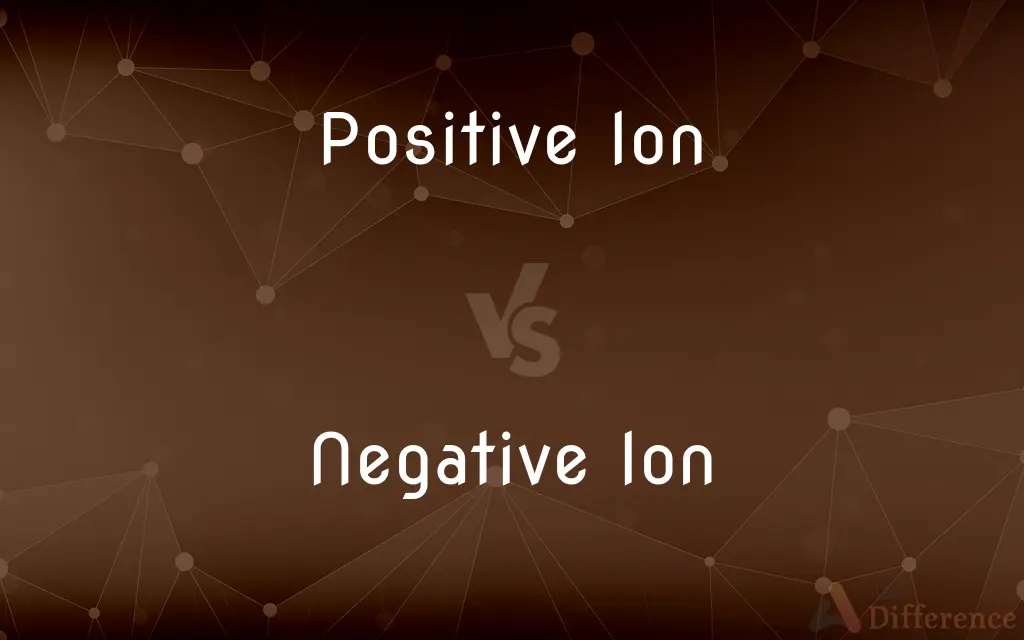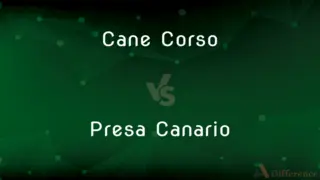Positive Ion vs. Negative Ion — What's the Difference?
By Tayyaba Rehman & Fiza Rafique — Published on February 10, 2024
A Positive Ion is an atom that has lost one or more electrons, resulting in a net positive charge, while a Negative Ion is an atom that has gained one or more electrons, resulting in a net negative charge.

Difference Between Positive Ion and Negative Ion
Table of Contents
ADVERTISEMENT
Key Differences
Positive Ions, or cations, are formed when atoms lose electrons, leading to a deficiency in negative charge. In contrast, Negative Ions, or anions, are produced when atoms gain extra electrons, resulting in an excess of negative charge. This fundamental difference in electron count underpins their distinct roles in chemical reactions.
In chemical bonding, Positive Ions typically act as electron acceptors due to their electron deficiency. Negative Ions, with their surplus electrons, often serve as electron donors, facilitating the formation of ionic bonds. This complementary nature is essential for the stability of many compounds.
The formation of Positive Ions is usually associated with metals that readily lose electrons. Conversely, Negative Ions are often formed from nonmetals, which have a higher tendency to gain electrons. This distinction is a key principle in understanding the periodic table and chemical behavior.
In biological systems, Positive Ions can affect cellular processes by altering the electrical balance, sometimes leading to adverse effects. Negative Ions, however, are often associated with beneficial health effects, such as improved mood and respiratory function, illustrating their diverse impacts on living organisms.
Environmental conditions can influence the concentration of Positive and Negative Ions. For example, electrical storms and certain types of air pollution can increase Positive Ion levels, while waterfalls and natural settings often have higher concentrations of Negative Ions, affecting both the environment and human well-being.
ADVERTISEMENT
Comparison Chart
Charge
Net positive due to loss of electrons.
Net negative due to gain of electrons.
Formation
Commonly formed from metals.
Typically formed from nonmetals.
Role in Chemical Bonds
Acts as electron acceptors.
Serves as electron donors.
Biological Impact
Can disrupt cellular balance, sometimes negatively.
Often associated with beneficial health effects.
Environmental Influence
Increased by certain pollutants and conditions.
Enhanced by natural phenomena like waterfalls.
Compare with Definitions
Positive Ion
Influencer of electrical balance in biological systems
Calcium ions play a crucial role as positive ions in muscle contractions.
Negative Ion
Commonly formed from nonmetals:
Oxygen often forms negative ions by gaining two electrons.
Positive Ion
Participant in ionic bonds as an electron acceptor
In NaCl, Na+ is the positive ion.
Negative Ion
Electron-rich atom:
In table salt, chlorine is present as a negative ion.
Positive Ion
Atom that has lost electrons
Sodium becomes a positive ion when it loses an electron.
Negative Ion
Contributor to air quality and health benefits:
Negative ions near waterfalls can improve mood and air quality.
Positive Ion
Electron-deficient atom
In salt, the sodium atom acts as a positive ion.
Negative Ion
Participant in ionic bonds as an electron donor:
Cl- acts as the negative ion in NaCl.
Positive Ion
Common in metals
Magnesium forms a positive ion by losing two electrons.
Negative Ion
Atom that has gained extra electrons:
Chlorine becomes a negative ion when it gains an electron.
Common Curiosities
Why are negative ions considered beneficial for health?
Negative ions can improve air quality and have been linked to positive effects on mood and respiratory conditions.
Are positive ions more common in urban environments?
Yes, urban areas often have higher concentrations of positive ions due to pollution and electronic devices.
What creates a positive ion?
A positive ion is created when an atom loses one or more electrons.
Can the presence of negative ions influence weather patterns?
Negative ions can influence weather by affecting cloud formation and precipitation processes.
Can an element form both positive and negative ions?
Typically, elements tend to form either positive or negative ions based on their position in the periodic table, but under specific conditions, certain elements might form both.
How do positive and negative ions form ionic bonds?
Positive and negative ions attract each other to form ionic bonds, creating a stable compound by balancing their charges.
Are negative ions always beneficial in any concentration?
While often beneficial, extremely high concentrations of negative ions in certain contexts might not always have positive effects.
Can the balance of positive and negative ions affect mental health?
Imbalances, particularly an excess of positive ions, have been linked to adverse effects on mood and stress levels.
How do positive ions affect the human body?
Positive ions can disrupt the body's electrical balance, potentially leading to negative health effects, particularly in polluted environments.
Do negative ions have an odor?
Negative ions themselves are odorless, but they can reduce odors by neutralizing pollutants.
How do air purifiers use negative ions?
Some air purifiers emit negative ions to attract and neutralize airborne pollutants and allergens.
How does the body regulate positive and negative ions?
The body maintains a balance of ions through cellular mechanisms and the use of electrolytes to ensure proper function.
What role do positive ions play in technology?
Positive ions are utilized in various technologies, including batteries and electronic displays.
Do foods contain positive or negative ions?
Foods can contain both types of ions, but they are more often discussed in terms of their mineral (ion) content rather than their ionic charge.
How can one increase exposure to negative ions naturally?
Spending time in natural settings like forests, mountains, or near water bodies can increase exposure to negative ions.
Share Your Discovery

Previous Comparison
Anthropocentrism vs. Biocentrism
Next Comparison
Cane Corso vs. Presa CanarioAuthor Spotlight
Written by
Tayyaba RehmanTayyaba Rehman is a distinguished writer, currently serving as a primary contributor to askdifference.com. As a researcher in semantics and etymology, Tayyaba's passion for the complexity of languages and their distinctions has found a perfect home on the platform. Tayyaba delves into the intricacies of language, distinguishing between commonly confused words and phrases, thereby providing clarity for readers worldwide.
Co-written by
Fiza RafiqueFiza Rafique is a skilled content writer at AskDifference.com, where she meticulously refines and enhances written pieces. Drawing from her vast editorial expertise, Fiza ensures clarity, accuracy, and precision in every article. Passionate about language, she continually seeks to elevate the quality of content for readers worldwide.
















































